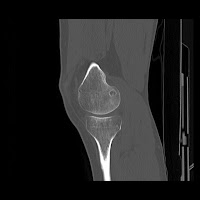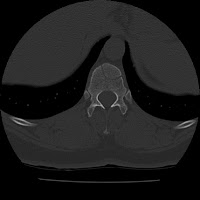The radiological image on the left is a femoral Osteoid Osteoma. On the right is a T8 compression fracture. Both of these images are CT scans. The military clinic where I work affords Physical Therapists the privilege of being able to order imaging like this when needed. This is an ability not available to Physical Therapists who do not work in military settings.
The person with knee pain had displayed a gradual onset of pain in his left knee. He was vague in locating the area where the pain was felt. There was no injury or event that provoked the pain and the knee had some mild swelling despite all special tests for mechanical structures returning a negative result. In other words, my clinical exam could not determine what was wrong.
The “muscle spasm” patient was even more tricky. There was a well documented incident where the patient, a nurse, had assisted in a transfer and felt pain and spasm immediately. The transfer was a simple slide up in the bed and seemed to have no ability to create any sort of serious injury. There was some red flags, however: extreme tenderness and protection upon palpation and the inability to sleep due to aching pain.
On both of my requests for radiology I included the term, “rule out underlying pathology.”
I was glad I did, and even more grateful for my ability to have access to these tests. Neither case was an emergency, but I fear that if I saw these same two patients in a civilian clinic, I might have been tempted to try a few session of therapy before deciding to send them back to their physician for more tests, which might or might not happen, and could take several weeks!
The ability of Physical Therapists to obtain radiological images seems like the next logical step in a move towards autonomous practice. There are many hurdles to this concept and a great debate is pending. Stay tuned…


